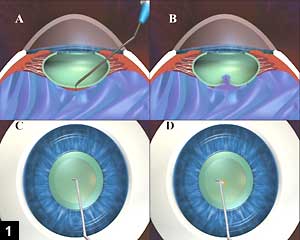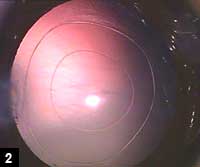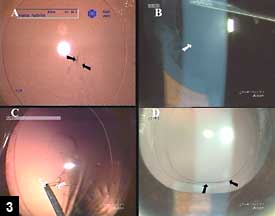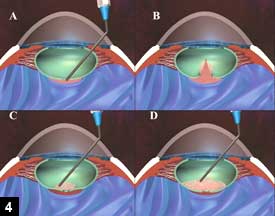Proper technique, viscoelastic needed for PCCC in congenital cataract surgery
Disruption of the vitreous face requiring vitrectomy is a risk, but IOL implantation in the bag is still possible in this event.
Manual capsulorrhexis remains a gold standard as it offers greater resistance to capsule tearing and also reveals a smooth regular edge. Capsulectomy performed with a vitrector or a diathermy may not withstand as much resistance to tearing as manual capsulorrhexis and it may not yield a strong opening. This holds true for posterior continuous curvilinear capsulorrhexis (PCCC), as well. PCCC resists peripheral extension of the tear and prevents herniation of the vitreous. However, other investigators have observed that performing posterior capsulorrhexis is technically difficult. A potential complication associated with this procedure is the disruption of the vitreous face. This study documents the completion rate of primary posterior capsulorrhexis during congenital cataract surgery and determines the incidence of disruption of the vitreous face.
Surgical technique
After lens aspiration using the bimanual irrigation and aspiration technique, the bag was refilled with Healon GV (sodium hyaluronate 1.4%, Advanced Medical Optics).
Initiation of PCCC was performed with the vertical element of a 26-gauge cystotome. Posterior depression was not performed, as it may have led to disruption of the anterior vitreous face (Figures 1A, 1B). The vertical element of the cystotome was held at a slant. Using a swiping motion, the posterior capsule was engaged and simultaneously directed toward the left, in the direction of the 3 o’clock position, and anteriorly, toward the microscope (Figures 1C, 1D). A flap was created by grasping the left of the inferior end of the puncture with Kraff-Utrata capsulorrhexis forceps and lifting it anteriorly, toward the microscope, as well as toward the 6 o’clock position (inferiorly). The edge of the flap was grasped and then re-grasped every 2 clock hours and the tear was directed toward the center and upward, fashioning the PCCC in a clockwise manner. The PCCC was approximately 3 mm to 4 mm and smaller than the anterior capsulorrhexis (Figure 2).
 Posterior depression was not performed, as it may have led to disruption of the anterior vitreous face (A, B). Using a swiping motion, the posterior capsule was engaged and simultaneously directed toward the left, in the direction of the 3 o’clock position, and anteriorly, toward the microscope (C, D). |  The PCCC was approximately 3 mm to 4 mm and smaller than the anterior capsulorrhexis. Images: Vasavada AR |
Results
The case series included 148 consecutive eyes undergoing cataract surgery; 106 pediatric patients were included. None of the patients had peripheral extension of the posterior capsulorrhexis. Disruption of the vitreous face was noted in five of 106 eyes (4.7%). In one eye (0.9%), disruption of the vitreous face occurred during initial puncture; in two eyes (1.8%), vitreous strands were seen adherent to the floating posterior capsule; and in two eyes (1.8%), deformation of the PCCC was observed. None of the patients had peaking of the pupil. The mean size of the PCCC was 3.59 ± 0.65 mm (range 2.5 mm to 5.5 mm).
Discussion
The posterior capsule is thinner, and there is a possibility of radial extension of PCCC and inadvertent disruption of the anterior vitreous face. Disruption of the vitreous face can be a major complication of peripheral extension of PCCC. The risk of vitreoretinal traction increases in cases of inadvertent anterior disruption of the vitreous face. The risk is also manifest in eyes with peripheral extension of PCCC with disruption of the vitreous face where extensive vitrectomy is required for its excision.
Signs of disruption of vitreous face
The following signs identify disruption of the vitreous face during PCCC:
- Visible strands that may be freely floating (Figure 3A, 3B);
- Presence of vitreous strands adherent to the capsular flap (Figure 3C);
- Sectorial deformation of the capsulotomy margin (Figure 3D).
Disruption of the vitreous face can occur during the puncture to initiate PCCC or even during the maneuver of elevating a flap or while attempting to re-grasp the capsule with the Uttrata forceps. To avoid disruption of the vitreous face, the initial puncture was made by holding the cystotome at a slant and subsequent elevation of the flap was performed by lifting the flap anteriorly, or toward the cornea. Additional viscoelastic was not injected through the central puncture of the capsule, as it may have made the posterior capsule convex and directed the tear peripherally (Figure 4a, 4b). Due to the possibility of inadvertent excessive injection making the capsule convex, viscoelastic was injected around the area of the initial puncture to achieve a flat or concave capsule. (Figure 4C, 4D).
|
|
|
The investigators suggested that with the slightest hint of a stray tear, the flap needed to be re-grasped close to the torn edge of the CCC margin to achieve a small, centric PCCC. During the entire procedure, the direction of the tear was not only toward the center but also anteriorly, toward the cornea. This maneuver, along with frequent re-grasping, enabled the surgeon to perform PCCC of the desired size without peripheral extension.
The investigators attributed the absence of peripheral extension of PCCC in the current study to the surgical technique and appropriate viscoelastic used and also the experience of the surgeon in performing this procedure.
Using the appropriate technique and viscoelastic, posterior capsulorrhexis can be consistently performed during congenital cataract surgery. Inadvertent disruption of the vitreous face necessitating vitrectomy might occur; however, implantation of an IOL in the bag can still be achieved in most cases. The eyes with inadvertent disruption of the vitreous face require follow-up for posterior segment complications.
For more information:
- Abhay R. Vasavada, MD, MS, FRCS, director of the Iladevi Cataract and IOL Research Centre, can be reached at Gurukul Road, Memnagar Ahmedabad – 380052 India; +91-79-27490909 or +91-79-27492303; fax: +91-79-27411200; e-mail: shailad1@sancharnet.in. The authors have no financial or proprietary interest in any product mentioned.


